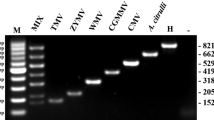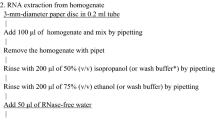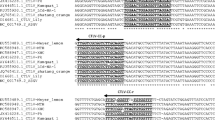Abstract
A reverse transcription-polymerase chain reaction (RT-PCR) was developed for the detection of little cherry virus (LChV), a closterovirus responsible for heavy yield losses in sweet cherry. Total RNA was extracted from the leaves of sweet cherry trees affected with 21 virus isolates from different locations in Germany, the Netherlands, the UK, and Switzerland, and used as template for RT-PCR. In all the samples tested, 274-277-nt products were amplified with a pair of oligonucleotide primers specific for the 3′-terminal 276-nt genomic region of the German LChV UW1 isolate of which the complete genome sequence has been published. The PCR products derived from 9 isolates were cloned and sequenced. The sequence comparisons revealed high homology between these isolates and UW1 (86.9% to 96.7% nt sequence identity), thus indicating that the RT-PCR assay may be applicable for the detection of a wide spectrum of natural LChV isolates.
Similar content being viewed by others
References
Agranovsky AA, Koonin EV, Boyko VP, Maiss E, Frötschl R, Lunina NA and Atabekov JG (1994) Beet yellows closterovirus: Complete genome structure and identification of a leader papain-like thiol protease. Virology 198: 311-324
Büttner C, Zahn V, Jelkmann W and Graf H (1993) Die Klein-früchtigkeit der Süßkirsche-eine gefürchtete Virose im nord-deutschen Steinobstbau. Mitteilungen des Obstbauversuchsringes des Alten Landes 9: 345-359
Büttner C, Jelkmann W and Graf H (1994) Zum Auftreten der Kle-infrüchtigkeit der Süßkirsche (little cherry disease) in deutschen Erwerbsobstanlagen. Erwerbs-Obstbau 1: 10-13
Dodds JA and Bar-Joseph M (1983) Double-stranded RNA from plants infected with closteroviruses. Phytopathology 73: 419-423
Eastwell KC and Bernardy MG (1996) Association of high molecular weight double-stranded RNA with little cherry disease. Canadian Journal of Plant Pathology 18: 203-208
Eastwell KC and Li TSC (1994) Status of the little cherry disease eradication program in the Kootenay Valley of British Columbia. Canadian Plant Disease Survey 74: 115-116
Eastwell KC, Bernardy MG and Li TSC (1996) Comparison between woody indexing and a rapid hybridisation assay for the diagnosis of little cherry disease in cherry trees. Annals of Applied Biology 128: 269-277
Hamilton RI, Dodds JA and Raine J (1980) Some properties of a nucleic acid associated with little cherry disease. Acta Phytopathologica Academicae Scientiarum Hungaricae 15: 75-77
Harms M, Büttner C, Graf H and Schickedanz F (1996) Untersuchungen zur Ausbreitung der virösen Kleinfrüchtigkeit der S¨ußkirsche (Little cherry disease) in norddeutschen Erwerbsobstanlagen. Erwerbs-Obstbau 1: 2-7
Higgins DG and Sharp PM (1988) CLUSTAL: A package for performing multiple sequence alignment on a microcomputer. Gene 73: 237-244
Jelkmann W (1995) Cherry virus A: cDNA cloning of dsRNA, nucleotide sequence analysis and serology reveal a new plant capillovirus in sweet cherry. Journal of General Virology 76: 2015-2024
Jelkmann W and Keim-Konrad R (1997) An immuno-capture polymerase chain reaction and plate trapped ELISA for the detection of apple stem pitting virus. Journal of Phytopathology 145 (in press)
Jelkmann W, Kunze L, Vetten HJ and Lesemann D-E (1992) cDNA cloning of dsRNA associated with apple stem pitting disease and evidence for the relationship of the virus-like agents associated with apple stem pitting and pear vein yellows. Acta Horticulturae 309: 55-62
Jelkmann W, Fechtner B and Agranovsky AA (1997) Complete genome structure and phylogenetic analysis of little cherry virus, a mealybug transmissible closterovirus. Journal of General Virology 78: 2067-2071
Jesperson GD and Carter G (1994) Little cherry virus survey in the Okanagan Valley of British Columbia. Canadian Plant Disease Survey 74: 117
Kaden-Kreuziger D, Lamprecht S, Martin RR and Jelkmann W (1995) Immunocapture polymerase chain reaction assay and ELISA for the detection of strawberry mild yellow edge associated potexvirus. Acta Horticulturae 385: 33-40
Keim-Konrad R and Jelkmann W (1996) Genome analysis of the 3′ terminal part of the little cherry disease associated dsRNA reveals a monopartite clostero-like virus. Archives of Virology 141: 1437-1451
Kinard GR, Scott SW and Barnett OW (1996) Detection of apple chlorotic leaf spot and apple stem grooving viruses using RTPCR. Plant Disease 80: 616-621
Korschineck I, Himmler G, Sagl R, Steinkellner H and Katinger HWD (1991) A PCR membrane spot assay for the detection of plum pox virus RNA in bark of infected trees. Journal of Virological Methods 31: 139-146
MacKenzie DJ, McLean MA, Mukerji S and Green M (1997) Improved RNA extraction from woody plants for the detection of viral pathogens by reverse transcription-polymerase chain reaction. Plant Disease 81: 222-226
Marchuk D, Drumm M, Saulino A and Collins FS (1990) Construction of T-vectors, a rapid and general system for direct cloning of unmodified PCR products. Nucleic Acids Research 19: 1154
Mawassi M, Mietkiewska E, Gofman R, Yang G and Bar-Joseph M (1996) Unusual sequence relationships between two isolates of citrus tristeza virus. Journal of General Virology 77: 2359-2364
Raine J, Weintraub M and Schroeder B (1975) Flexuous rods and vesicles in leaf and petiole phloem of little-cherry diseased Prunus spp. Phytopathology 65: 1181-1186
Raine J, Weintraub M and Schroeder B (1979) Hexagonal tubules in phloem cells of little cherry infected trees. Journal of Ultrastructural Research 67: 109-1
Raine J, McMullen RD and Forbes RD (1986) Transmission of the agent causing little cherry disease by the apple mealybug Phenacoccus aceris and the dodder Cuscuta lupuliformis. Canadian Journal of Plant Pathology 8: 6-11
Rowhani A, Chay C, Golino DA and Falk BW (1993) Development of a polymerase chain reaction technique for the detection of grapevine fanleaf virus in grapevine tissue. Phytopathology 83: 749-753
Sambrook J, Fritsch EF and Maniatis T (1989). In: Molecular Cloning-A Laboratory Manual (2nd edn.) Cold Spring Harbor Laboratory, New York
Welsh MF and Cheney PW (1976): Little cherry. In: Gilmer RM, Moore JD, Nyland G, Welsh MF and Pine TS. Washington, D.C. (eds) Virus Diseases and Noninfectious Disorders of Stone Fruits in North America. USDA Agriculture Handbook no. 437 (pp 231-237) Agricultural Research Serv
Wetzel T, Candresse T, Macquaire G, Ravelonandro M and Dunez J (1992) A highly sensitive immunocapture polymerase chain reaction method for plum pox potyvirus detection. Journal of Virological Methods 39: 27-37
Author information
Authors and Affiliations
Rights and permissions
About this article
Cite this article
Vitushkina, M., Fechtner, B., Agranovsky, A. et al. Development of an RT-PCR for the detection of little cherry virus and characterization of some isolates occurring in Europe. European Journal of Plant Pathology 103, 803–808 (1997). https://doi.org/10.1023/A:1008679224682
Issue Date:
DOI: https://doi.org/10.1023/A:1008679224682




